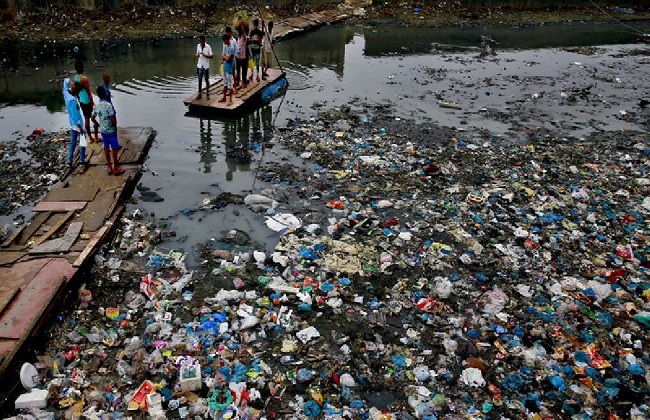
It’s been clear for some time: We’re in the midst of a rapidly escalating global plastics crisis. More than 11 billion metric tons of virgin plastics were produced worldwide from 1950 to 2022. And the rate of production has soared, with at least 71% of all plastics ever made produced in the 21st century.
Of all those billions of tons manufactured, three-quarters were discarded in landfills, open dumps or directly into the environment. Today, our oceans, beaches, rivers, cities and wild places are awash in discarded plastic and synthetic textiles, while microplastics have been detected from pole to pole, on remote mountaintops and in clouds.
In view of the tremendous buildup of visible trash, it’s not surprising that the plastics crisis so far has mostly been treated as a problem of poor waste management and consumer choice. Likewise, efforts for a fix have largely focused on recycling and consumer education.
But talking about plastic as a litter problem ignores one of the most alarming facets of our plastic addiction: its impacts on human health.
Fast-mounting evidence points to microplastics entering the human body and doing internal damage. Likewise, thousands of chemicals that leach out of plastics are finding their way into our bodies (via food wrappers, storage containers, cooking utensils and other routes) with some of those chemicals linked to a range of health impacts, including immune suppression and cancer.
In a new report out Nov. 7th in the journal One Earth, an international group of researchers attempted to gather all of plastic’s myriad negative impacts into a global framework ahead of the final round of negotiations for a global plastics treaty scheduled to run Nov. 25 to Dec. 1 in Busan, Korea.
The report puts it bluntly: “Despite the manifest benefits of plastics, plastics pollution now threatens the environment, food security, and human health.”
What’s lurking inside that spatula?
The trouble starts at the very beginning of the supply chain, when petroleum is extracted and processed into the petrochemical ingredients for plastic.
Plastics are often marketed as if they are simple, pure polymers — labeled, for example, as polyester, polyurethane, PVC and more. And while we do know that PVC and polystyrene can leach hazardous substances such as styrene, phthalates and vinyl chloride, there are other dangers lurking in these generically labeled polymers.
Plastic packaging, toys, clothing, kitchenware and construction materials almost always include a proprietary mix of chemicals: processing aids and additives such as plasticizers, flame retardants and pigments, which can make up to 70% of their weight, according to the One Earth report.
Some of these chemicals are known to be carcinogenic, mutagenic and reproductively and developmentally toxic. Of the more than 16,000 chemicals used to make plastic, or present in plastic materials and products, more than 4,200 — up to two–thirds of the chemicals used or found in well-studied plastic types — are of concern because they are persistent, bioaccumulative, mobile and/or toxic. Hazard information is lacking for another 10,000.
But research has shown that these chemicals don’t stay inside plastics; untold numbers of them, in unknown amounts, end up inside us. A study published in September found that more than 3,600 chemicals are found in both plastic food packaging and in human blood, indicating that these chemicals are leaching out of plastics — whether from packaging into food or from microplastics that we ingest into our bodies.
Researchers are scrambling to understand what plastic and its chemical additives are doing to us, an effort greatly slowed by a stunning lack of transparency from the petrochemical industry as to what chemicals are in what plastics.
But scientists are increasingly warning that the rising rates of cancer, lung disease, infertility and obesity are due not solely to lifestyle factors but to environmental pollutants, including those in plastics. For example, a May 2024 study linked higher rates of breast cancer to the presence in outdoor air of chemicals used to make polystyrene and PVC plastics.
Of particular concern are plasticizers, or endocrine disrupting chemicals added to plastics to make them soft and pliable, including BPA and its many bisphenol cousins and phthalates. PFAS, a toxic class of chemicals known as “forever chemicals” because they never break down or go away, are also endocrine disruptors and often found in plastics.
Hormone disrupting chemicals have been associated with hormone-related cancers, diabetes and cardiovascular disease. A 2020 meta analysis showed that people with higher levels of endocrine disruptors in their bodies were more likely to be obese. A 2022 study showed that the presence of more endocrine disruptors in the bodies of women trying to get pregnant was associated with a lower chance of success.
Plastic makers have traditionally proposed recycling as the solution to the plastics crisis. But recycling done wrong can amplify plastic’s toxicity. Take for example, black plastic spatulas, takeout containers and even children’s toys were recently found to contain high levels of flame retardants and flagged as a public health problem. That’s because the black plastic used to make electronics (which can be toxic and was never intended for use in connection with food) is frequently recycled in developing nations (where there is little to no regulation or oversight) and turned into new plastic products.
Plastic products continue to be a potential source of toxins even after disposal. While a single-digit percentage of plastics get recycled, an estimated 14% of all the plastic ever created has been incinerated, which can release plastics into the air and environment in the form of tiny particulates (linked to lung and heart disease), heavy metals such as lead and mercury and dioxins, which have been linked to impairment of the immune system, reproductive system and the development of the nervous system in children.
Talking about plastic as a litter problem ignores one of the most alarming facets of our plastic addiction: its impacts on human health. Image by Lucien Wanda via Pexels (Public domain)
Microplastics, macro problem
The other huge public health problem with plastics arises when they start to degrade — either in our homes while we’re using them, or after they end up in the environment. Plastics over time degrade into smaller and smaller pieces. The result is microplastics, which are found everywhere on Earth.
Microplastics from many sources find their way into our bodies in a typical day: Plastic microfibers are shed from clothing and furnishings; nanoplastics leach out of food packaging and containers (especially when we microwave them). Microplastics are found in the produce we eat, tap water and, especially, bottled water, beer, seafood and the air we breathe. One study found that microplastics can end up in baby formula when it’s prepared in polyethylene bottles.
They’ve also been found throughout the human body — in brain tissue, lungs, placentas, breast milk, livers, testes and blood. The microscopic plastics found in humans range from PET (used in polyester clothing and plastic water bottles) to polyethylene (stretchy plastic, milk jugs and shampoo bottles) and PVC (shower curtains, vinyl construction products and clear plastic fashion accessories).
How microplastics interact with human organs or how they impact body function remains largely unknown, as microplastics and health is a new field of study. But alarm bells are already sounding in the scientific community.
A study published in March found that half of patients with asymptomatic cardiovascular disease had microplastics in their carotid artery plaque and were at higher risk of a heart attack, stroke and death in the next three years than those who did not. A similar correlation has been found between the presence of microplastics in feces and inflammatory bowel disease. In the lab, microplastics can be deadly to human cells.
Rodent studies have shown that microplastics affect the lungs, liver, intestines and the reproductive and nervous systems. And at least one of those rodent studies found that even “clean” microplastics that are free of hazardous additives can cause health problems.
It’s important to note here, correlation does not prove causality: Scientists say it may take years to trace the precise mechanisms by which microplastics and thousands of plastic additives impact our health. In the meantime, the American Chemistry Council has responded to these early warnings by saying the research is inconclusive and pointing to the complexity of plastics.
And it’s true: Microplastic particles may be almost as unique as snowflakes — they come in all sizes, shapes, colors and types, containing secretive mixtures of thousands of chemicals.
This complexity means it might be impossible to find a definitive causal (as opposed to correlative) link to myriad potential health effects … at least within our lifetimes. That’s why many scientists are urging world leaders to adhere to the precautionary principle and take action to protect human and animal health now, based on the evidence we have so far. Otherwise, astronomical levels of plastic waste could overwhelm the natural world and accumulate in our bodies while we wait decades to line up incontrovertible evidence.
Taking action against an insidious threat
When confronted with these alarming public health studies, some people look for ways to reduce their personal exposure to plastic, microplastics and additives.
But because plastics and microplastics are ubiquitous — because there are no mandated disclosures about what is in plastic products and because so many chemicals in plastics have never been analyzed for their health impacts — it has become an impossible task for individuals or communities to avoid plastic’s harms altogether.
“Plastics are seen as those inert products that protect our favorite products or that make our lives easier that can be ‘easily cleaned up’ once they become waste. But this is far from reality,” says PhD candidate Patricia Villarrubia-Gómez at the Stockholm Resilience Centre at Stockholm University and lead author of the One Earth report. “Plastics are made out of the combination of thousands of chemicals … with which we interact on a daily basis.”
Researchers, activists and a 66 nation coalition known as the High Ambition Coalition to End Plastic Pollution are calling for the full life cycle of plastics to be regulated, from the extraction of petroleum, to the creation of plastic’s petrochemical ingredients and their safe disposal. They’ll make their case at the fifth U.N. plastics treaty summit to be held Nov. 25 to Dec. 1 in Busan, South Korea, where delegates hope to finalize treaty language for future ratification by the world’s nations.
In August, the Biden administration indicated it would support limits on plastic production, which, scientists and advocates say, would be the simplest solution to protecting human health. But now, with the election of Donald Trump as U.S. president, Biden has reverted to the original weaker U.S. position, of allowing nations to voluntarily set their own limits on production. With the Busan summit less than a week away, some environmental advocates fear that the changing winds of politics and policy in the U.S. may not bode well for a strong binding agreement addressing plastic production, cradle to grave.
(This article was republished from Mongabay Under Creative Commons License)
Alden Wicker is an award-winning journalist, sustainable-fashion expert, and founder and editor-in-chief of EcoCult. She’s published investigative pieces for The New York Times, Vogue, Wired, and has been interviewed for the BBC, NPR, Reuters, Fortune and CBC.


